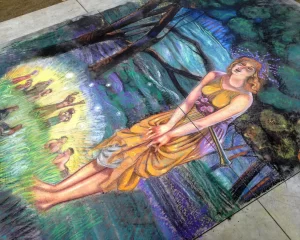In 2016, I attended the “Artists’ Confab” in Chicago for the Big Walls Project, a huge street art initiative headed up by Columbia College. These are some of the things I learned.

Mark Kelly, of Columbia College, is the program director and the visionary behind the project. In 2013 they decided to go big with an intention to “transform the whole district:” namely, the Wabash corridor on the South Side of Chicago. They started with a few modest installations, performances and of course murals, and by 2014 they had a Brantley, a Shepard Fairey, list goes on and on. They made great, compelling street art, and Columbia students and the overall community responded with great positivity. This enthusiasm led to momentum, and now the Big Walls Project is one of the more notable street art projects in the country.
In his opening address, Kelly remembers the pioneers of outdoor street art. He also recalls the state of the area. “Wabash has for a long time been a forlorn and forgotten street. Bare walls, drab, dreary, with weeds, etc. But there were amazing restaurants, cafes and bars.” He saw the potential, and knew that street art would be a catalyst for change.
Said Kelly, “Who said that walls had to be: Either bare, or full of crass marketing messages?”
From the Wabash Arts Corridor website: “In just a few years, WAC has managed to connect students, artists, entrepreneurs, local businesses and commerce with educational and cultural programming for the visual, performing and media arts. The result has been the emergence of WAC as a key player in the city as an urban lab for creative expression, innovation and excellence in the arts.”
The heart of WAC is Wabash Avenue from Van Buren to Roosevelt and is framed to the east by Michigan Avenue and to the west by State Street. The corridor was called a “living urban canvas” due to its ever growing number of large-scale mural installations and collaborative projects.
While WAC anticipated the district to grow and develop further as a living laboratory, it sadly only lasted 3 years. It was organized by eight educational institutions, and 19 galleries. I have to wonder why the project fizzled out.






